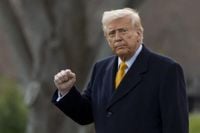On October 3, 2025, the United States Treasury set off a political and legal firestorm when U.S. Treasurer Brandon Beach unveiled draft images of a new $1 commemorative coin featuring the face of President Donald Trump. The coin, intended to mark the nation’s 250th birthday in 2026, immediately became a lightning rod for debate over the longstanding American tradition—and legal requirement—that only deceased individuals appear on U.S. currency.
According to images shared by Treasurer Beach on X (formerly Twitter), the obverse of the proposed coin features a profile of Trump, with the word "Liberty" above and the dates "1776-2026" below. The reverse side depicts Trump standing before a U.S. flag, fist raised in a gesture that recalls his response after surviving an assassination attempt the previous year, and encircled by the words "FIGHT FIGHT FIGHT." Beach’s post declared, “No fake news here. These first drafts honoring America’s 250th Birthday and @POTUS are real.” The post quickly drew attention, with Beach adding that more information would be forthcoming once the federal government’s partial shutdown ended.
The Treasury Department was quick to clarify that these were preliminary mock-ups, not final designs. A spokesperson explained, “This first draft reflects well the enduring spirit of our country and democracy, even in the face of immense obstacles.” Yet, as reported by Colombia One and The Hill, the mere existence of the design triggered a wave of legal scrutiny and partisan bickering.
At the heart of the controversy lies a tangle of federal laws and traditions. A statute dating back to 1866, enacted after a bureaucrat named Spencer Clark put his own image on a five-cent note, has long barred living people from appearing on paper currency. However, that law applies only to notes produced by the Bureau of Engraving and Printing, not to commemorative coins minted by the U.S. Mint. The Circulating Collectible Coin Redesign Act of 2020, which authorizes the Treasury Secretary to mint $1 coins “with designs emblematic of the United States semiquincentennial,” appears to allow some flexibility. Still, it also states that “no head and shoulders portrait or bust of any person, living or dead, and no portrait of a living person may be included in the design on the reverse of specified coins.”
Legal experts, as cited by Colombia One, have speculated that the draft’s depiction of Trump on the reverse—showing him in a full-figure pose rather than a classic "head and shoulders" portrait—may be an attempt to skirt the letter of the law. But the question remains: does the design comply with the spirit, or even the precise wording, of the 2020 law’s restrictions?
The Treasury, for its part, defended the plan. On October 6, 2025, the Department issued a statement noting that the coin was authorized under the 2020 law and that Treasury Secretary Scott Bessent was exercising his authority to issue coinage “with designs emblematic of the United States semiquincentennial.” The Department’s post on X asserted, “On this momentous anniversary, there is no profile more emblematic for the front of this coin than that of our serving President, Donald J. Trump.”
Predictably, reaction in Washington was swift and polarized. White House spokesperson Karoline Leavitt told reporters she was unsure whether Trump had seen the draft but added, “I’m sure he’ll love it.” Meanwhile, Democratic lawmakers wasted no time in voicing their objections. Bronx Congressman Ritchie Torres (D-NY) announced plans to introduce the TRUMP Act—short for The Restrict Ugly Money Portraits Act. The bill would prohibit any sitting president from issuing currency featuring their own likeness and would require all U.S. currency to depict only deceased individuals. Torres did not mince words, stating, “America’s money should only feature big, beautiful faces — not big, ugly faces.”
Commemorative coins, it should be noted, are legal tender but are generally not minted for general circulation. They are often produced in limited quantities for collectors or to mark significant national milestones. The U.S. Mint has a long history of issuing such coins, including the 1976 bicentennial quarter and $1 coin, which featured the Liberty Bell and the moon after a nationwide design competition. More recently, commemoratives have honored deceased American icons, from civil rights leaders to astronauts.
This latest proposal, however, is unprecedented in modern times for featuring a living president. The last time a living person appeared on U.S. currency was before the 1866 law, and that episode was widely condemned as an abuse of public trust. The tradition of honoring only the deceased on money, as explained on an archived Treasury website, is meant to avoid even the faintest whiff of monarchy or self-aggrandizement in a republic founded on democratic ideals.
Adding to the controversy, the Trump administration’s decision comes just months after President Trump ordered the Treasury to halt penny production, citing the fact that it costs more to mint the coin than it’s worth. This move, while based on economic reasoning, fueled further debate about the administration’s approach to the nation’s currency and its symbolism. Trump is no stranger to such disputes: during his first term, he delayed an Obama-era plan to put Harriet Tubman on the $20 bill, dismissing it as “pure political correctness.”
The cost of producing the new $1 coin remains unclear, according to The New York Times. It will depend on the materials selected and the quantity ultimately minted. While commemorative coins are not meant to replace circulating currency, their symbolic value is considerable—especially when they coincide with major national anniversaries like the upcoming semiquincentennial.
As of October 6, 2025, Treasury officials emphasized that the design process for the 250th anniversary coins is ongoing and that no final $1 coin design has been selected. Still, the debate over whether a living president should grace U.S. currency is unlikely to fade anytime soon. With the legal landscape murky and political passions running high, some observers predict that the fate of the Trump coin could ultimately be decided in the courts.
For now, the coin’s draft design stands as a potent symbol—not just of America’s upcoming milestone, but of the larger questions facing the nation about tradition, legality, and the meaning of its most enduring icons.




